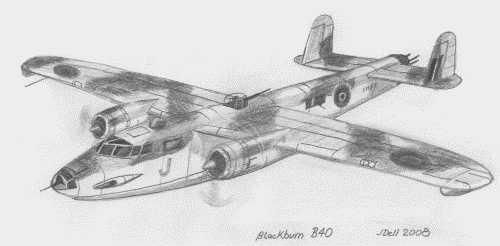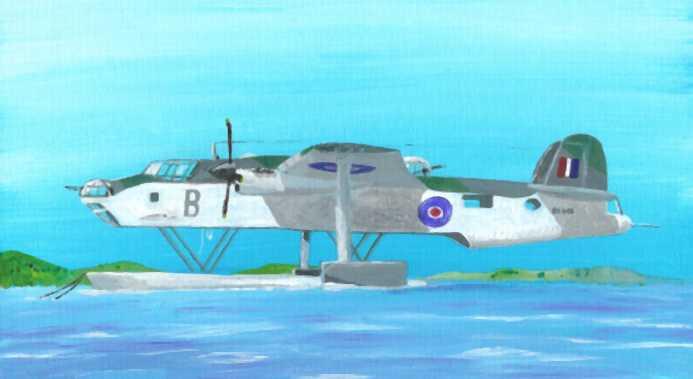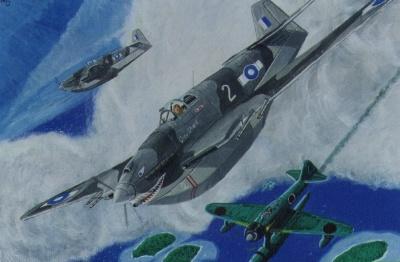Dinger's Aviation Pages
Blackburn B40

Above is a sketch of what the B40 might have looked like if built with Bristol Centaurus engines. The sketch is based on a layout which appeared in issue 130 (summer 2007) of Air Britains Aeromilitaria magazine. I have elected to draw it with a Boulton-Paul dorsal turret with single 20mm cannon (such a turret was test-flown on a Defiant) and a four-gun rear turret and a single hand-operated gun in the nose, with a 40mm gun mounted to fire forward. This layout best conforms with the outline of the aircraft as it appears in Aeromilitaria magazine. However, the actual specification set out the defensive armament as two turrets each with two .50-inch machine guns, a 20 mm cannon in a power-operated mounting and 4 other .303-inch machine guns to be operated through side windows or hatches.
The Blackburn B40 retracting-bottom flying boat was a follow-on design to the Blackburn B20. The B20 had been designed with a shorter range (1,500 miles) than the mighty four-engined Sunderland Flying Boat (2,500 miles), but by 1940 the American PBY Catalina had shown that a two-engined design could achieve the same endurance as the Sunderland and operate more economically. So in April 1940 (a few weeks after the loss of the B20 prototype), a new specification (R13/40) was issued for a Sunderland replacement based around using the same principles as the B20, to be powered by either two Napier Sabre or Bristol Centaurus engines. It was anticipated that the new design would have the same range as the Sunderland but with increased speed and more effective defensive armament, to include a 20 mm cannon and perhaps a Vickers 40mm mounted in the nose for offensive use. The B40 design looked essentially similar to the B20 but had twin fins instead of the B20's single fin. The B40 was anticipated to be complementary to the R14/40 project for a large flying boat with increased range (which led to the Short Shetland). The Saro company also prepared a design for the R14/40 specification with a large 4-engined flying boat that used Blackburn's retracting-bottom technology (the Saro S39A) but it was never formally tendered to the Air Ministry.

An alternate view of what the B40 might have ended up looking like: this time with Napier Sabre inline engines, the specified 20 mm cannon mounted in the tail and two turrets with twin .50-inch machine guns, one situated awkwardly in the nose and the other turret in a dorsal position, mounted further back to give a better downward view.
At the time the B40 specification was written the need to be able to patrol in the middle of the Atlantic was not anticipated since the hunting grounds of the U boats were then in the Atlantic approaches, but with the success of radar-equipped aircraft by Coastal Command, the U-boats were forced to operate at greater ranges. Thus in early 1941, it was felt desirable to increase the range of the B40 to at least 3,000 miles. Design work continued and two prototypes were ordered (the serial numbers ES966 and ES979 being allocated) but it was just not possible to achieve the range required with two engines while still retaining armament, a decent bomb load and an acceptable single-engine performance, so the project was wound-down in late 1941 with formal cancellation in January 1942.
Blackburn B44

Blackburn B44, painted as it might have appeared if it had gone into service. In this case, a pair have just attacked a Japanese A6M2-N "Rufe" floatplane fighter.
The last project to feature a retracting float was the Blackburn B44 fighter to specification N2/42, a follow-on from Air Ministry Operational Requirement OR144. It was designed around a Napier Sabre engine of 2,000 hp driving contra-rotating propellers, it was intended to be armed with four 20mm cannons. Descriptions of the aircraft stress that it was to incorporate large parts of the Blackburn Firebrand fighter in its structure (the project had grown out of the earlier B43 which was just the Firebrand with two traditional fixed floats). However, the diagrams that survive seem to show little commonality with the Firebrand, for example, the Firebrand had straight-edged tapered wings whereas B44 diagrams show elliptical wings. The B44 was meant for use in island-hopping campaigns in the Far East and Pacific, operating out of sheltered anchorages. Extensive tests of models were done in water tanks to ensure that spray would not swamp the engine on take-off and landing. A top speed of 355 mph (571 kph) at 24,000 feet (7,315 metres) was hoped for, along with a ceiling of at least 30,000 feet (9,144 metres). The ability to carry two 500 lb (227 kg) bombs or two drop tanks was also specified. The project suffered from the extended development of the Firebrand and was eventually cancelled, although the idea of a flying-boat fighter was kept alive in the Saunders-Roe SR.A1 powered by jet engines.

Blackburn B44.
Sources:
Air Britain Aeromilitaria Magazine Volume 33 Issue 130 Summer 2007 article "Blackburn B20, B40 and B44"
Air Britain Aeromilitaria Magazine Volume 26 Issue 103 Autumn 2000 article "Retractable Float Seaplane" (B44)
British Secret Projects - Fighters & Bombers 1935-1950: By Tony Buttler, Midland Publishing 2004 ISBN 1 85780 179 2.
The British Aircraft Specification File: KJ Meekcoms & EB Morgan, Air-Britain Publications 1994 ISBN 0 85130 220 3
Blackburn Aircraft Since 1909: By AJ Jackson, published by Putnam, ISBN 370 000536
Saunders and Saro Aircraft Since 1917: By Peter London, published by Putnam, ISBN 0 85177 814 3.
Air Britain Aeromilitaria Magazine Volume 33 Issue 130 Summer 2007 article "Blackburn B20, B40 and B44"
Air Britain Aeromilitaria Magazine Volume 26 Issue 103 Autumn 2000 article "Retractable Float Seaplane" (B44)
British Secret Projects - Fighters & Bombers 1935-1950: By Tony Buttler, Midland Publishing 2004 ISBN 1 85780 179 2.
The British Aircraft Specification File: KJ Meekcoms & EB Morgan, Air-Britain Publications 1994 ISBN 0 85130 220 3
Blackburn Aircraft Since 1909: By AJ Jackson, published by Putnam, ISBN 370 000536
Saunders and Saro Aircraft Since 1917: By Peter London, published by Putnam, ISBN 0 85177 814 3.
